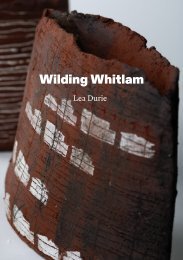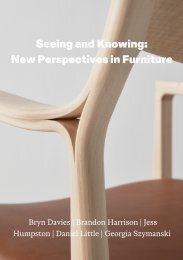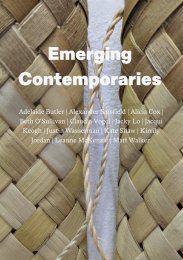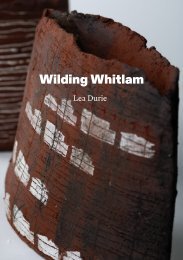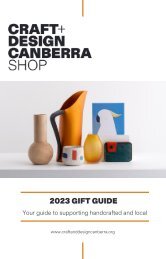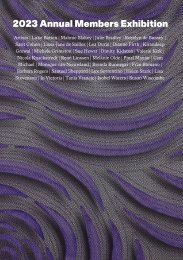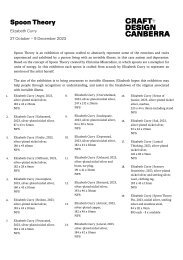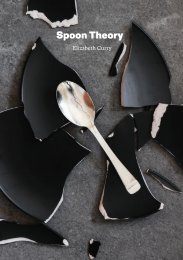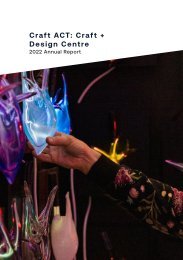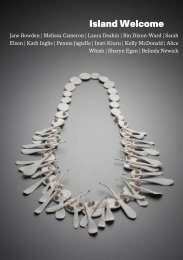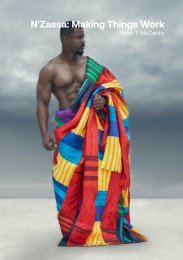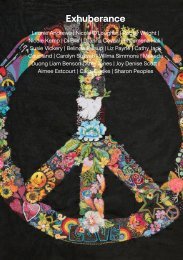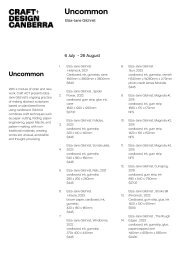Craft ACT Aritst-in-residence program 2016
10 year catalogue 2016 residents: Cathy Franzi and Sione Maileseni
10 year catalogue
2016 residents: Cathy Franzi and Sione Maileseni
You also want an ePaper? Increase the reach of your titles
YUMPU automatically turns print PDFs into web optimized ePapers that Google loves.
CRAFT <strong>ACT</strong>: CRAFT + DESIGN CENTRE<br />
ARTIST-IN-RESIDENCE:<br />
arts, heritage & the environment<br />
2006-<strong>2016</strong>
RESIDENCIES<br />
<strong>2016</strong> ARTIST-IN-RESIDENCE<br />
Sione Maileseni, K<strong>in</strong>gdom of Tonga<br />
15 September – 14 October <strong>2016</strong><br />
Cathy Franzi, Canberra<br />
4 October – 31 October <strong>2016</strong><br />
Location: Gudgenby Ready-Cut Cottage, Namadgi<br />
National Park, Australian Capital Territory<br />
<strong>2016</strong> RESEARCH PARTNER<br />
National Arboretum Canberra<br />
PUBLIC PROGRAM<br />
10 Year Anniversary Celebration Day<br />
Saturday, 17 September <strong>2016</strong><br />
Namadgi National Park Visitors Centre<br />
10 YEAR ANNIVERSARY CELEBRATION DAY<br />
PARTICIPANTS<br />
Ruth H<strong>in</strong>gston 2015<br />
Mary Hutchison 2015<br />
Sally Blake 2014<br />
Annee Miron 2014<br />
Christ<strong>in</strong>e Atk<strong>in</strong>s 2012<br />
Marily C<strong>in</strong>tra 2012<br />
Marian Hosk<strong>in</strong>g 2012<br />
Bernard Morris 2006 - 2011<br />
Kirstie Rea 2009<br />
Zsuzsi Soboslay 2009<br />
Paull McKee 2009<br />
Joanne Searle 2006<br />
EXHIBITION<br />
7 April – 13 May 2017<br />
<strong>Craft</strong> <strong>ACT</strong>: <strong>Craft</strong> + Design Centre Gallery<br />
2<br />
Cover: <strong>in</strong> front: Nils Desperandum at Tidb<strong>in</strong>billa<br />
Nature Reserve Image: Andrew Sikorski – Art<br />
Atelier, Ready-Cut Cottage <strong>in</strong> the Gudgenby<br />
Valley Image: Andrew Sikorski - Art Atelier
CONTENTS<br />
INTRODUCTION<br />
Rachael Coghlan, CEO / Artistic Director, <strong>Craft</strong> <strong>ACT</strong>: <strong>Craft</strong> + Design Centre<br />
4-5<br />
ARTISTS-IN-RESIDENCY … TEN YEARS OF COLLABORATION, CRAFT AND<br />
DESIGN<br />
Brett McNamara, Regional Manager, <strong>ACT</strong> Parks and Conservation Service<br />
6 – 7<br />
THE IMPORTANCE OF TREES<br />
Scott Sadler, Executive Director, National Arboretum Canberra<br />
8 – 9<br />
THE ARTIST-IN-RESIDENCE PROGRAM AND GUDGENBY READY-CUT<br />
COTTAGE STORY<br />
Bernard Morris, formerly Ranger-<strong>in</strong>-Charge, Namadgi National Park<br />
10 – 14<br />
INSPIRATIONAL LANDSCAPES<br />
Karen Viggers<br />
Author of The Strand<strong>in</strong>g, The Lightkeeper’s Wife and The Grass Castle<br />
15 – 19<br />
ARTIST-IN-RESIDENCE: ARTS, HERITAGE AND THE ENVIRONMENT<br />
TEN-YEAR CELEBRATION EXHIBITORS<br />
20 – 21<br />
Cathy Franzi<br />
Sione Maileseni<br />
Mary Hutchison<br />
Ruth H<strong>in</strong>gston<br />
Sally Blake<br />
Annee Miron<br />
Christ<strong>in</strong>e Atk<strong>in</strong>s<br />
Marily C<strong>in</strong>tra<br />
Marian Hosk<strong>in</strong>g<br />
Kirstie Rea<br />
Joanne Searle<br />
Zsuzsi Soboslay<br />
Bernard Morris<br />
22 – 23<br />
24 – 25<br />
26 – 29<br />
30<br />
31<br />
32<br />
33<br />
34<br />
35<br />
36<br />
37<br />
38 – 39<br />
40 – 41<br />
CELEBRATION DAY<br />
CREDITS<br />
ACKNOWLEDGEMENTS<br />
42 – 43<br />
44 – 45<br />
46 – 47<br />
3
4<br />
Work <strong>in</strong> progress by 2014 resident Sally<br />
Blake Image: Andrew Sikorski – Art Atelier
INTRODUCTION<br />
Anniversaries are a good time to reflect on the<br />
changes brought about by the passage of time.<br />
In <strong>2016</strong> we proudly celebrated the ten-year<br />
anniversary of the <strong>Craft</strong> <strong>ACT</strong>: <strong>Craft</strong> + Design<br />
Centre annual artist-<strong>in</strong>-<strong>residence</strong> <strong>program</strong> that<br />
gives a lead<strong>in</strong>g craft artist, designer or writer<br />
the opportunity to immerse themselves <strong>in</strong> the<br />
environment of Namadgi National Park. This<br />
remarkable collaboration allows artists to translate<br />
the beautiful and <strong>in</strong>f<strong>in</strong>itely variable qualities of both<br />
craft and nature to the contemporary world.<br />
<strong>Craft</strong> <strong>ACT</strong> and the <strong>ACT</strong> Parks and Conservation<br />
Service established the residency as a symbol of<br />
resilience and optimism <strong>in</strong> the wake of the 2003<br />
bushfires that swept through the landscape west<br />
of Canberra and <strong>in</strong>to our city. In the decade s<strong>in</strong>ce<br />
it was set up, the <strong>program</strong> has become as rhythmic<br />
as the seasons <strong>in</strong> the annual offer<strong>in</strong>gs of <strong>Craft</strong><br />
<strong>ACT</strong>: a ritual that reveals surprise and <strong>in</strong>spiration.<br />
We are as happy to be its caretaker and witness as<br />
our friends at the Parks Service are to care for the<br />
Ready-Cut Cottage <strong>in</strong> the Gudgenby Valley, where<br />
the artists reside.<br />
Time is relative. This <strong>program</strong> is ten years old, <strong>Craft</strong><br />
<strong>ACT</strong> is more than 40 years old, craft practice <strong>in</strong><br />
the Namadgi area is as old as its habitation by the<br />
Ngunnawal people, and the landscape itself is much<br />
older still. When an artist accepts our <strong>in</strong>vitation<br />
to stay <strong>in</strong> the park as part of this <strong>program</strong>, they<br />
are travers<strong>in</strong>g these timel<strong>in</strong>es and these histories,<br />
their <strong>in</strong>tersections and diversions. The residency<br />
br<strong>in</strong>gs precious stillness, solitude and space: artists<br />
have found, time and aga<strong>in</strong>, that their practice is<br />
profoundly altered by the experience of nature, as<br />
you will see <strong>in</strong> the work <strong>in</strong> this catalogue.<br />
The anniversary is an opportunity for us to thank<br />
the <strong>ACT</strong> Parks and Conservation Service for their<br />
cont<strong>in</strong>u<strong>in</strong>g collaboration and energetic advocacy<br />
of this important <strong>program</strong> for the Canberra<br />
community. I would also like honour the many<br />
people who have shaped the <strong>program</strong> over the years:<br />
the research partners, arts<strong>ACT</strong>, former directors of<br />
<strong>Craft</strong> <strong>ACT</strong>, current and former staff and, of course,<br />
the artists themselves.<br />
Rachael Coghlan • CEO / Artistic Director<br />
<strong>Craft</strong> <strong>ACT</strong>: <strong>Craft</strong> + Design Centre<br />
February 2017<br />
5
ARTISTS-IN-RESIDENCY<br />
TEN YEARS OF COLLABORATION, CRAFT AND DESIGN<br />
On a devastat<strong>in</strong>gly hot summer’s day a firestorm<br />
swept across the mounta<strong>in</strong>s of the bush capital, lives<br />
were lost, impacted, and altered forever. Recover<strong>in</strong>g<br />
from the ashes, a simple conversation led to a<br />
unique relationship, an affiliation between the<br />
Parks Service and a pool of gifted arts practitioners.<br />
The genesis of collaboration grew out of a desire<br />
to weave an engag<strong>in</strong>g narrative, a storyl<strong>in</strong>e that<br />
captures <strong>in</strong> the imag<strong>in</strong>ation the <strong>in</strong>tr<strong>in</strong>sic natural and<br />
cultural values of this primordial landscape.<br />
The em<strong>in</strong>ent naturalist, environmentalist and astute<br />
observer of the natural world John Burroughs once<br />
declared ‘I go to nature to be soothed and healed,<br />
and to have my senses put <strong>in</strong> order’.<br />
In an era of digital dependence, where screen time<br />
dom<strong>in</strong>ates and green time is a precious commodity,<br />
Burroughs’ powerful <strong>in</strong>sight speaks to the <strong>in</strong>fluence<br />
that nature has <strong>in</strong> simply connect<strong>in</strong>g us with our<br />
environment. When you venture <strong>in</strong>to the majestic<br />
Br<strong>in</strong>dabella Ranges, there is little wi-fi connectivity<br />
but you have a much better connection with nature.<br />
With a generational shift to a sedentary lifestyle, a<br />
predom<strong>in</strong>antly <strong>in</strong>door existence has been l<strong>in</strong>ked to<br />
a range of contemporary health issues. This trend<br />
towards physical <strong>in</strong>activity has been attributed to a<br />
number of <strong>in</strong>fluences <strong>in</strong>clud<strong>in</strong>g the dawn of screenbased<br />
technologies and <strong>in</strong>creas<strong>in</strong>g risk-aversion.<br />
The implications of this change for our health<br />
system will have far-reach<strong>in</strong>g consequences for our<br />
community.<br />
The artist-<strong>in</strong>-<strong>residence</strong> philosophy is underp<strong>in</strong>ned<br />
by values that we <strong>in</strong>st<strong>in</strong>ctively appreciate. We are<br />
not separate from nature but a part of it. This is<br />
not an <strong>in</strong>novative concept, but a revival of what our<br />
forbearers understood. Spend<strong>in</strong>g time <strong>in</strong> nature and<br />
connect<strong>in</strong>g with nature is good for the m<strong>in</strong>d, the<br />
body and the soul. Nature can <strong>in</strong>deed nurture.<br />
Here <strong>in</strong> the bush capital we f<strong>in</strong>d ourselves absorbed<br />
by natures’ artistic endeavours. The ancient<br />
mounta<strong>in</strong>s are a place of sheer splendour, where<br />
nature flourishes, evolves with the seasons, where<br />
clear water flows, where people can f<strong>in</strong>d <strong>in</strong>sight,<br />
purpose and mean<strong>in</strong>g.<br />
Today, the artist-<strong>in</strong>-<strong>residence</strong> <strong>program</strong> has created a<br />
diverse catalogue of creative artistic <strong>in</strong>terpretation<br />
born from a spiritual and emotional connection to<br />
these mounta<strong>in</strong>s. These supremely talented craft<br />
practitioners have successfully connected people<br />
with parks, <strong>in</strong>vit<strong>in</strong>g a broader community audience<br />
to immerse themselves <strong>in</strong> this serene environment.<br />
The residency <strong>program</strong> is designed to accentuate<br />
the light, sounds and seasons of this dist<strong>in</strong>ctive<br />
environmental landscape. This is achieved through<br />
artistic <strong>in</strong>terpretation utilis<strong>in</strong>g mediums as diverse<br />
as textiles and wood, and techniques as dist<strong>in</strong>ct as<br />
weav<strong>in</strong>g, engrav<strong>in</strong>g and sculpture. The result <strong>in</strong>vites<br />
us to pause and contemplate an artistic reflection of<br />
the <strong>in</strong>herent values of this landscape.<br />
Achiev<strong>in</strong>g national prom<strong>in</strong>ence through local<br />
and <strong>in</strong>ternational acclaim, the artist-<strong>in</strong>-<strong>residence</strong><br />
<strong>program</strong> is without parallel <strong>in</strong> its contribution to a<br />
community conversation that captures this unique<br />
landscape as be<strong>in</strong>g one of outstand<strong>in</strong>g natural<br />
significance to the national capital, the city and<br />
people of Canberra.<br />
Brett McNamara<br />
Regional Manager<br />
<strong>ACT</strong> Parks and Conservation Service<br />
February 2017<br />
6
2012 resident Christ<strong>in</strong>e Atk<strong>in</strong>s with <strong>ACT</strong> Parks and<br />
Conservation Service rangers Image Andrew Sikorski<br />
7
8<br />
Workshop material by Cathy Franzi Image:<br />
Madel<strong>in</strong>e McGuigan – Edge Light Photography
THE IMPORTANCE OF TREES<br />
The National Arboretum Canberra hosted its first<br />
artist-<strong>in</strong>-<strong>residence</strong> <strong>in</strong> <strong>2016</strong>, <strong>in</strong> partnership with <strong>Craft</strong><br />
<strong>ACT</strong>: <strong>Craft</strong> + Design Centre and <strong>ACT</strong> Parks and<br />
Conservation Service.<br />
The National Arboretum is home to 44,000 rare<br />
and symbolic trees from Australia and across the<br />
world. Communicat<strong>in</strong>g the importance of trees, tree<br />
conservation and scientific research is one of our key<br />
goals. Visual art is able to communicate all of these<br />
elements <strong>in</strong> creative and accessible ways.<br />
Local ceramics artist Cathy Franzi immersed herself<br />
<strong>in</strong> the National Arboretum’s liv<strong>in</strong>g collection of<br />
forests and gardens. She turned the light-filled<br />
Terrace Room <strong>in</strong>to her studio and soaked up her<br />
surround<strong>in</strong>gs, spend<strong>in</strong>g time outdoors walk<strong>in</strong>g,<br />
observ<strong>in</strong>g, touch<strong>in</strong>g, draw<strong>in</strong>g and photograph<strong>in</strong>g the<br />
plants.<br />
The work she produced mirrored the landscape,<br />
comb<strong>in</strong><strong>in</strong>g strength, botanical precision and<br />
tranquillity.<br />
Inspired by the wide range of tree species grow<strong>in</strong>g<br />
<strong>in</strong> the Arboretum, Cathy shared her imag<strong>in</strong>ation<br />
and skills with the public by offer<strong>in</strong>g a pr<strong>in</strong>t<strong>in</strong>g<br />
workshop us<strong>in</strong>g leaves, seeds and nuts gathered <strong>in</strong><br />
the forests.<br />
She held a workshop for eight-to-15-year olds and<br />
explored the diversity of leaf shape and texture<br />
through the pr<strong>in</strong>t medium. The participants enjoyed<br />
learn<strong>in</strong>g new pr<strong>in</strong>t<strong>in</strong>g techniques and the workshop<br />
was a great success.<br />
The Arboretum was fortunate to also host Sione<br />
Maileseni from the K<strong>in</strong>gdom of Tonga, an artist who<br />
weaves coconut fibre. Sione’s complex and <strong>in</strong>tricate<br />
weav<strong>in</strong>g, us<strong>in</strong>g fibre sourced directly from coconut<br />
trees, proved to be fasc<strong>in</strong>at<strong>in</strong>g for visitors to the<br />
Arboretum. For two weeks Sione sat among the<br />
visitors <strong>in</strong> the Village Centre, draw<strong>in</strong>g <strong>in</strong>spiration<br />
from the views and natural environment to create<br />
f<strong>in</strong>e weav<strong>in</strong>gs.<br />
He generously shared his skills and knowledge,<br />
show<strong>in</strong>g visitors his weav<strong>in</strong>g techniques and<br />
expla<strong>in</strong><strong>in</strong>g the connections between his current<br />
work and traditional Kato Kafa weav<strong>in</strong>g techniques<br />
from the 1700s, which is a revered thread <strong>in</strong> Tonga’s<br />
social history. Children were particularly attracted<br />
to, and enchanted by, Sione’s unique weav<strong>in</strong>gs and<br />
his warm and engag<strong>in</strong>g way of communicat<strong>in</strong>g.<br />
A key element of the residency <strong>program</strong> is to further<br />
build the artists’ knowledge and understand<strong>in</strong>g,<br />
which <strong>in</strong> turn enriches and expands their experience<br />
and abilities to foster collaborations across artistic<br />
networks and cultures.<br />
While <strong>in</strong> Canberra, Sione was <strong>in</strong>spired by an<br />
exhibition of work by the Fibre Basket Makers of<br />
<strong>ACT</strong> at Strathnairn Gallery, Holt. At the same time,<br />
an Arboretum staff member serendipitously loaned<br />
Sione a British Museum exhibition catalogue of<br />
South Pacific weav<strong>in</strong>gs. The exhibition and catalogue<br />
<strong>in</strong>spired new ideas and motivated Sione to employ<br />
different ways of mak<strong>in</strong>g, comb<strong>in</strong><strong>in</strong>g traditional<br />
weav<strong>in</strong>g techniques with contemporary designs.<br />
The artist-<strong>in</strong>-<strong>residence</strong> <strong>program</strong> was a natural fit<br />
for the National Arboretum and, not surpris<strong>in</strong>gly,<br />
Arboretum staff found that they shared many traits<br />
and perspectives with the artists – they are <strong>in</strong>spired<br />
by curiosity and driven to seek knowledge and solve<br />
problems.<br />
We were delighted to see how Cathy and Sione<br />
<strong>in</strong>terpreted the Arboretum’s liv<strong>in</strong>g collection<br />
through their art, and we thank the artists and the<br />
artist-<strong>in</strong>-<strong>residence</strong> <strong>program</strong> partners for a fruitful<br />
shared experience.<br />
Scott Sadler<br />
Executive Director<br />
National Arboretum Canberra<br />
9
THE ARTIST-IN-RESIDENCE PROGRAM AND<br />
GUDGENBY READY-CUT COTTAGE STORY<br />
PROLOGUE<br />
Dur<strong>in</strong>g my time as the ranger-<strong>in</strong>-charge at Namadgi<br />
National Park between 2006 and 2011, I had the<br />
opportunity to work with colleagues and partners on<br />
two major developments, the refurbishment of the<br />
Gudgenby Ready-Cut Cottage and the <strong>in</strong>itiation of<br />
the artist-<strong>in</strong>-<strong>residence</strong> <strong>program</strong> <strong>in</strong> collaboration with<br />
the <strong>Craft</strong> <strong>ACT</strong>: <strong>Craft</strong> + Design Centre.<br />
THE ARTIST-IN-RESIDENCE PROGRAM – GENESIS<br />
The artist-<strong>in</strong>-<strong>residence</strong> <strong>program</strong> is an endur<strong>in</strong>g<br />
collaboration between <strong>Craft</strong> <strong>ACT</strong>: <strong>Craft</strong> + Design<br />
Centre and the <strong>ACT</strong> Parks and Conservation Service.<br />
In its formative stages <strong>in</strong> 2005, Brett McNamara and<br />
I, of the Parks Service, collaborated with Barbara<br />
McConchie and Diana Hare of <strong>Craft</strong> <strong>ACT</strong>. The first<br />
residencies were themed ‘Memories <strong>in</strong> Place’ (2006)<br />
and ‘Artists <strong>in</strong> Place’ (2009).<br />
How did the residency idea start, though? I recall<br />
that a spontaneous period of positive and creative<br />
energy led to a partnership between two disparate<br />
art and place entities. Meet<strong>in</strong>gs took place where<br />
ideas were exchanged and good will, a sense of<br />
experimentation and humour formed part of the<br />
mix. But this was little without the enthusiasm of<br />
the fabulous craft artists who were will<strong>in</strong>g to spend<br />
their time and energy <strong>in</strong> periodic <strong>residence</strong> <strong>in</strong> our<br />
wonderful ‘Namadgic’ places, shar<strong>in</strong>g their skills<br />
and perceptions.<br />
Be<strong>in</strong>g different entities <strong>in</strong> expertise and practice,<br />
there was naturally some separation of ideas<br />
10
and priorities. The Parks Service saw an artistic<br />
residency as a fabulous opportunity to <strong>in</strong>vite a new<br />
section of the community <strong>in</strong>to the Namadgi space<br />
– with which rangers and park workers already<br />
had a great and privileged <strong>in</strong>timacy – to witness<br />
the magic and wonder and share their response to<br />
the landscapes they found themselves <strong>in</strong>. Our view<br />
was that Namadgi is a whole-of-community asset<br />
and our job was to open the door to it more widely<br />
and broaden its relevance and appeal. This has<br />
worked wonderfully thanks to the ongo<strong>in</strong>g efforts<br />
and commitment of both <strong>Craft</strong> <strong>ACT</strong> and the Parks<br />
Service, and the generosity of the many creative<br />
craft artists who have participated through the<br />
years.<br />
MEMORIES IN PLACE<br />
The first residency, ‘Memories <strong>in</strong> Place’, was<br />
based at three huts on the ‘Settler’s Track’ <strong>in</strong> far<br />
southern Namadgi – Waterhole Hut, Waterman’s<br />
Homestead and Brayshaws Hut. The recently<br />
developed ‘Settler’s Track’ passes each of these huts<br />
through stunn<strong>in</strong>g and beautiful landscapes. Each<br />
hut presents <strong>in</strong>formation that tells their stories:<br />
why they are there and why they are important.<br />
Paull McKee, Joanne Searle and Daniel Mag<strong>in</strong>nity<br />
were the pioneer<strong>in</strong>g craft artists under the new<br />
artist-<strong>in</strong>-<strong>residence</strong> <strong>program</strong>. Paull at Waterhole,<br />
Daniel at Waterman’s and Joanna at Brayshaw’s<br />
each produced different <strong>in</strong>terpretive works from<br />
these locations. The huts are rudimentary and the<br />
artists were unable to live <strong>in</strong> them dur<strong>in</strong>g their<br />
residency, which limited their capacity to immerse<br />
themselves <strong>in</strong> place. Nonetheless the artists<br />
produced thematic and <strong>in</strong>sightful work that the<br />
public were <strong>in</strong>vited to view on-site, travell<strong>in</strong>g by bus<br />
to and from Brayshaw’s Hut. From Brayshaw’s, the<br />
visitors explored on foot, walk<strong>in</strong>g between the huts<br />
and meet<strong>in</strong>g the artists. Despite our professional<br />
familiarity with the huts and their landscape<br />
sett<strong>in</strong>gs, as staff, we were surprised and enlightened<br />
by the perceptions of the artists. It was a lesson<br />
<strong>in</strong> the breadth of world views and how a person’s<br />
response to place and history is deeply personal.<br />
ARTISTS IN PLACE<br />
‘Artists <strong>in</strong> Place’ moved the location for the<br />
artistic residency to the Ready-Cut Cottage <strong>in</strong> the<br />
Gudgenby Valley. The comfortable accommodation<br />
and a stipend provided through <strong>Craft</strong> <strong>ACT</strong> made it<br />
possible for Paull McKee (as a cont<strong>in</strong>u<strong>in</strong>g artist) and<br />
Kirstie Rea to reside <strong>in</strong>dividually for five weeks. This<br />
<strong>in</strong>itiated an emerg<strong>in</strong>g artists-<strong>in</strong>-<strong>residence</strong> tradition<br />
at Gudgenby Ready-Cut Cottage. Like Paull, Joanna<br />
and Daniel from the first residential project, new<br />
material emerged from this residency that reflected<br />
the artists’ sense of the Gudgenby Valley <strong>in</strong> the<br />
midst of Namadgi – illum<strong>in</strong>at<strong>in</strong>g, ponder<strong>in</strong>g,<br />
reflective, notional and specific. Their work arose<br />
out of thorough immersion <strong>in</strong> the environment<br />
and was based on profound personal reflective<br />
experience. Paull donated a tapestry from this time<br />
that hangs <strong>in</strong> the cottage to this day.<br />
THE GUDGENBY READY-CUT COTTAGE<br />
The Gudgenby Cottage is a ‘ready-cut’ kit home<br />
manufactured by George Hudson Limited <strong>in</strong> Sydney<br />
<strong>in</strong> 1927. It sits on a low rise south-east of the<br />
<strong>in</strong>tersection of the Gudgenby River and Hospital<br />
Creek. This location is <strong>in</strong> the south-eastern corner<br />
of the larger than 600-hectare Gudgenby Valley, an<br />
area that was last farmed by the Bootes family <strong>in</strong><br />
the lead-up to the ultimate declaration of Namadgi<br />
National Park <strong>in</strong> 1984 (extended <strong>in</strong> 1991).<br />
11
12<br />
Paull McKee, Hobart Wagga detail, textiles.<br />
Image: Andrew Sikorski - Art Atelier
Hudson’s opened <strong>in</strong> Sydney <strong>in</strong> 1846 and became<br />
one of the major east-coast timber and hardware<br />
suppliers. Some of Hudson’s early projects <strong>in</strong>cluded<br />
the construction of Sydney’s first horse-drawn<br />
trams, the supply of prefabricated timber build<strong>in</strong>gs,<br />
and the production of 1,000 railway carriages<br />
for the State Railways Department. Curiously, <strong>in</strong><br />
1914, Hudson supplied timber from a 100-yearold<br />
sugar p<strong>in</strong>e to the famous Hawaiian surfer<br />
Duke Kahanamoku, who then shaped it <strong>in</strong>to his<br />
‘longboard’. Hudson promoted its prefabricated<br />
‘ready-cut’ homes as the ‘latest orig<strong>in</strong>al designs of<br />
beautiful bungalows at small cost’. Hudson became<br />
a major supplier of prefabricated construction and<br />
the company’s onl<strong>in</strong>e history refers to ‘an excellent<br />
example’ be<strong>in</strong>g the ‘Gudgenby Ready-Cut Cottage<br />
which has been restored by the <strong>ACT</strong> Parks and<br />
Conservation Service and is open to the public’.<br />
In an isolated landscape without established<br />
transport l<strong>in</strong>ks, a ‘ready-cut’ approach to hous<strong>in</strong>g<br />
was a sensible solution that provided all the<br />
necessary materials and a system for quick<br />
establishment. The improv<strong>in</strong>g track access to<br />
the Gudgenby Valley enabled sufficient transport<br />
capacity for pre-fabricated hous<strong>in</strong>g to be<br />
considered. It was for similar portability and quick<br />
establishment qualities that Mawson’s Hut <strong>in</strong><br />
Antarctica is a modified version of the same type of<br />
pre-fabricated structure at Gudgenby.<br />
Prior to the ‘Artists <strong>in</strong> Place’ residency, the<br />
Gudgenby Cottage was gradually deteriorat<strong>in</strong>g,<br />
despite the best efforts of the Namadgi park rangers.<br />
With tremendous collegiate and car<strong>in</strong>g support<br />
provided by the Kosciuszko Huts Association<br />
(KHA), led by their Namadgi huts officer of the<br />
time, Richard Stanley, and aided by a fortuitous <strong>ACT</strong><br />
Heritage Grant, the Gudgenby Cottage was brought<br />
back from the br<strong>in</strong>k of collapse and restored <strong>in</strong><br />
2008. The refurbishment was a major achievement.<br />
In those days Richard, with typical enthusiasm<br />
and commitment, would phone me and with a<br />
raspy voice and ask directly ‘what are we go<strong>in</strong>g to<br />
do about …?’, galvanis<strong>in</strong>g me to do someth<strong>in</strong>g,<br />
anyth<strong>in</strong>g, to keep the project progress<strong>in</strong>g. Through<br />
KHA’s dedication, love of the huts and Namadgi<br />
landscapes, and sense of duty and responsibility, the<br />
Gudgenby Cottage is now a key feature of Namadgi<br />
that is available, appropriately, for community use.<br />
The Parks Service subsequently substantially<br />
enhanced KHA’s restoration <strong>in</strong>itiative with<br />
expensive <strong>in</strong>vestments <strong>in</strong> water, firefight<strong>in</strong>g,<br />
electricity and sewage systems. The cottage’s<br />
<strong>in</strong>terior was thoroughly refurbished with polished<br />
timber floors and other homely accessories,<br />
<strong>in</strong>clud<strong>in</strong>g beds, sofas, chairs, curta<strong>in</strong>s, a fridge, a<br />
slow combustion heater and a new fuel stove (the<br />
latter heaved <strong>in</strong>to place and flued by the Parks<br />
Service’s dedicated field officers). Even the ceil<strong>in</strong>g<br />
was <strong>in</strong>sulated with fibreglass batts! (This was a<br />
lonely, sweaty and dusty job, I recall). The kitchen<br />
cab<strong>in</strong>et was salvaged from a former shear<strong>in</strong>g shed<br />
near Majura and many bits and pieces came from<br />
local antique outlets. We unfortunately made the<br />
mistake of not consult<strong>in</strong>g Trish Bootes, a former<br />
farm<strong>in</strong>g family resident of the Gudgenby Homestead<br />
and a member of staff, who could have helped<br />
<strong>in</strong>form the fit-out endeavours.<br />
13
EPILOGUE<br />
The artist-<strong>in</strong>-<strong>residence</strong> <strong>program</strong> has been, and<br />
cont<strong>in</strong>ues to be, a resound<strong>in</strong>g success for Namadgi<br />
National Park and the region’s craft artists. I<br />
congratulate everyone <strong>in</strong>volved <strong>in</strong> its <strong>in</strong>ception and<br />
cont<strong>in</strong>uation. I greatly look forward to spend<strong>in</strong>g<br />
future days <strong>in</strong> the landscapes I love at Gudgenby<br />
and to visit<strong>in</strong>g and witness<strong>in</strong>g the <strong>in</strong>terpretive<br />
skills of tomorrow’s craft artists. With good will,<br />
the <strong>in</strong>sights and creativity of the craft artists will<br />
cont<strong>in</strong>ue to <strong>in</strong>form us for generations and help<br />
us achieve a more unified and profound sense of<br />
identity and belong<strong>in</strong>g.<br />
Bernard Morris<br />
Formerly Ranger-<strong>in</strong>-Charge<br />
Namadgi National Park<br />
December <strong>2016</strong><br />
14<br />
Gudgenby Ready-Cut Cottage<br />
Image: Andrew Sikorski - Art Atelier
INSPIRATIONAL LANDSCAPES<br />
ART WOULD NEVER BE ABLE TO EXIST WITHOUT NATURE.<br />
PIERRE BONNARD<br />
It’s night <strong>in</strong> Namadgi National Park. Cold. Clear.<br />
No moon. I’m out here alone, layered <strong>in</strong> thermals,<br />
frost form<strong>in</strong>g on my hair, chilled f<strong>in</strong>gers tucked<br />
under armpits. I’m supposed to be radio track<strong>in</strong>g<br />
kangaroos, but the sky stops me with its scattered<br />
curta<strong>in</strong> of flung stars. I lie on the silver grass and<br />
gaze <strong>in</strong>to the universe, listen<strong>in</strong>g to the crackle of<br />
the bush, the snipp<strong>in</strong>g teeth of kangaroos graz<strong>in</strong>g<br />
nearby, t<strong>in</strong>y creatures rustl<strong>in</strong>g <strong>in</strong> tussocks. In the<br />
distance I see the fa<strong>in</strong>t outl<strong>in</strong>e of domed granite<br />
peaks. Everyth<strong>in</strong>g is old and new, m<strong>in</strong>iscule and<br />
large, near and far, magical. I feel whole. Alive. By<br />
day, it is different, but the same. Instead of sound<br />
and shades of grey, it is light and texture and colour<br />
that speak. Patterns. Shadows. Smell.<br />
This is the space <strong>in</strong> which creativity beg<strong>in</strong>s. When<br />
a soul is moved, a seed germ<strong>in</strong>ates and art may be<br />
born. For me, the wide grassy valleys of Namadgi<br />
and the surround<strong>in</strong>g granite crags triggered the idea<br />
for my novel, The Grass Castle. The first fronds of<br />
story came from the sound of w<strong>in</strong>d <strong>in</strong> the eaves of<br />
the old Orroral Valley homestead. I thought about<br />
the settlers who had lived there, and the Indigenous<br />
moth-hunters who roved the mounta<strong>in</strong>s before<br />
them, connected to country. Place, light and air<br />
gave rise to story, along with the lonel<strong>in</strong>ess of the<br />
valley, h<strong>in</strong>ts of the past <strong>in</strong> the newspaper-l<strong>in</strong>ed walls<br />
of the hut, other ru<strong>in</strong>ed build<strong>in</strong>gs and old fences<br />
laced with lichen. I wanted to use my writ<strong>in</strong>g to<br />
explore the way history and the environment are<br />
<strong>in</strong>terwoven. The way the natural world shapes us <strong>in</strong><br />
contrast to the ways <strong>in</strong> which we change the world.<br />
My ecologist husband derives <strong>in</strong>spiration from<br />
nature <strong>in</strong> a different way. As a scientist, he seeks<br />
to measure and understand the environment, to<br />
explore l<strong>in</strong>ks between habitat and animals, and<br />
gather data to help expla<strong>in</strong> ecosystems. He has<br />
strong spiritual bonds with the natural world<br />
too and, when we walk <strong>in</strong> wild places, while I am<br />
15
16
17<br />
Gudgenby Valley Image: Bernard Morris
th<strong>in</strong>k<strong>in</strong>g of words to create pictures, he is look<strong>in</strong>g<br />
at patterns <strong>in</strong> landscapes and th<strong>in</strong>k<strong>in</strong>g about how<br />
it all fits together, how to test ideas and develop<br />
hypotheses. The environment as stimulus for<br />
science. For word artists like me, it’s all about<br />
mood.<br />
The urge to represent nature through art stretches<br />
back through millennia. At Yankee Hat <strong>in</strong> Namadgi<br />
National Park, Indigenous artists, who lived <strong>in</strong><br />
the region prior to white occupation, used natural<br />
pigments to pa<strong>in</strong>t images of people and animals on<br />
granite rock. Art as a form of expression and pass<strong>in</strong>g<br />
on story. Art as a way of relat<strong>in</strong>g to the world.<br />
Nature’s powerful <strong>in</strong>fluence on art may come<br />
from a primal connection to landscape through<br />
our ancestors. Perhaps we carry memories buried<br />
<strong>in</strong> our DNA because, when we leave the urban<br />
environment and take pause <strong>in</strong> nature, when we<br />
stop to breathe, when we l<strong>in</strong>ger long enough to<br />
rediscover our true selves, peace, gratitude and<br />
<strong>in</strong>spiration can be found. In this space, we can<br />
locate our <strong>in</strong>ner flame of creativity. It doesn’t<br />
matter whether we use this energy to develop<br />
art that reflects nature, or whether we use it to<br />
motivate other projects. What matters is recognis<strong>in</strong>g<br />
opportunity and capitalis<strong>in</strong>g on it. While the muse<br />
burns we must tap <strong>in</strong>to it and channel this force<br />
<strong>in</strong>to our work.<br />
NATURE GETS INTO OUR SOULS AND OPENS<br />
DOORS TO HIDDEN PARTS OF OURSELVES.<br />
PAMELA HEYDA<br />
18
Why are nature and landscape so important as a<br />
source of <strong>in</strong>spiration for art? And what motivates<br />
us to create art? Who do we speak to? Why do<br />
we do it? The answers to these questions are as<br />
complex and varied as the many forms of art we use<br />
to convey our responses to nature. We may strive<br />
to capture what we see <strong>in</strong> a real or abstract way,<br />
through pa<strong>in</strong>t<strong>in</strong>g, photography, poetry or craft. Or<br />
we may want to share our experience with others<br />
and show them how we have been moved. In this<br />
busy world of <strong>in</strong>creas<strong>in</strong>gly urban existence, we may<br />
wish to rem<strong>in</strong>d people of our orig<strong>in</strong>s, of the country<br />
around us, of places where we can f<strong>in</strong>d peace and<br />
beauty outside the madness of our daily lives. We<br />
may work to motivate people to care about natural<br />
places because, if we care about country, then we<br />
value it and we may also fight to save it, especially<br />
as the climate changes, human populations <strong>in</strong>crease<br />
and we cont<strong>in</strong>ue to expand our impact on the Earth.<br />
confidence to tackle new th<strong>in</strong>gs. It’s no surprise that<br />
most retreats for artists are <strong>in</strong> quiet places, close to<br />
nature.<br />
Now it is daytime and I am driv<strong>in</strong>g south of Tharwa<br />
beneath a cloud-strewn sky through parched<br />
landscapes and <strong>in</strong>to straggly forest, country that<br />
has recovered from wildfire. The road changes to<br />
gravel and w<strong>in</strong>ds through shady gullies fragrant with<br />
lemon and pepperm<strong>in</strong>t. It traverses a stream and<br />
switches and climbs, ris<strong>in</strong>g over contours.<br />
I take the turn to Gudgenby, driv<strong>in</strong>g through open<br />
country, up past the shadowy homestead and on<br />
to the smaller rustic weatherboard Ready-Cut<br />
Cottage – a place where artists come to work.<br />
Stepp<strong>in</strong>g outside, I <strong>in</strong>hale mounta<strong>in</strong> air tangy with<br />
the rich aroma of grass. Already, tension is fad<strong>in</strong>g<br />
and lightness is settl<strong>in</strong>g on my sk<strong>in</strong> – that lovely<br />
sensation of the soul expand<strong>in</strong>g.<br />
A POET OUGHT NOT TO PICK NATURE’S<br />
POCKET. LET HIM BORROW, AND SO<br />
BORROW AS TO REPAY BY THE VERY <strong>ACT</strong> OF<br />
BORROWING.<br />
SAMUEL TAYLOR COLERIDGE<br />
The natural environment can be the muse or it<br />
can feed the muse. It can be the trigger for art<br />
or it can be a space where art is made. Artists<br />
f<strong>in</strong>d a place that speaks to them, and they work<br />
with<strong>in</strong> it, respond<strong>in</strong>g to scale, story, patterns,<br />
light. Sometimes all of these. There is also the<br />
communion with others that can be found <strong>in</strong> nature:<br />
the multiplicative effect that arises when shared<br />
passion exists between artists – a bright form of<br />
energy that not only motivates work, but also lends<br />
This is a place where art is made.<br />
ART IS AN ABSTR<strong>ACT</strong>ION; AS YOU DREAM<br />
AMID NATURE, EXTRAPOLATE ART FROM<br />
IT AND CONCENTRATE ON WHAT YOU WILL<br />
CREATE AS A RESULT.<br />
PAUL GAUGUIN<br />
Karen Viggers<br />
Author of The Strand<strong>in</strong>g, The Lightkeeper’s<br />
Wife and The Grass Castle<br />
19
ARTIST-IN-RESIDENCE: ARTS, HERITAGE AND THE ENVIRONMENT<br />
TEN-YEAR CELEBRATION EXHIBITORS<br />
20
Back row Left to right: Mary Hutchison, Zsuzsi Soboslay, Annee<br />
Miron, Sally Blake, Paull McKee, Sione Maileseni, Marian Hosk<strong>in</strong>g,<br />
Bernard Morris, Barb McConchie. Front row Left to right: Ruth<br />
H<strong>in</strong>gston, Marily C<strong>in</strong>tra, Cathy Franzi, Kirstie Rea, Joanne Searle<br />
Image: Madel<strong>in</strong>e McGuigan – Edge Light Photography<br />
21
22<br />
Cathy Franzi, Flora Survey: Reclaimed Boboyan P<strong>in</strong>e<br />
Plantation, 2017. Porcela<strong>in</strong>, stoneware, sgraffito, 10.5h<br />
x 36w x 31d cm. Image: Andrew Sikorski - Art Atelier
CATHY FRANZI<br />
CERAMICS<br />
<strong>2016</strong><br />
I was delighted to have the opportunity dur<strong>in</strong>g my<br />
month-long residency to experience and research<br />
two different but equally fasc<strong>in</strong>at<strong>in</strong>g environments,<br />
the National Arboretum Canberra and Gudgenby<br />
Valley <strong>in</strong> Namadgi National Park. The residency was<br />
particularly suited to my art practice <strong>in</strong> that I aim<br />
to communicate values of natural heritage and how<br />
they are <strong>in</strong>tr<strong>in</strong>sically l<strong>in</strong>ked to scientific and cultural<br />
knowledge.<br />
In preparation for mak<strong>in</strong>g, I researched the<br />
vegetation of the Gudgenby Valley as a way to reveal<br />
and express cultural, historical and environmental<br />
values. I selected three areas that I felt exemplified<br />
the valley’s environmental history and then<br />
established a flora survey by walk<strong>in</strong>g, observ<strong>in</strong>g<br />
and identify<strong>in</strong>g the plant species that are currently<br />
grow<strong>in</strong>g <strong>in</strong> each site.<br />
The first artwork is based on Boboyan P<strong>in</strong>e<br />
Plantation, the land for which was first cleared<br />
and planted <strong>in</strong> the 1960s and subsequently logged,<br />
burnt and its environmental values reconsidered.<br />
From 1998, volunteers <strong>in</strong> the Gudgenby Bush<br />
Regeneration Group have restored a remarkable<br />
biodiversity. My ‘plot’ depicts many of the plants<br />
that are mak<strong>in</strong>g a comeback amongst remnant P<strong>in</strong>us<br />
radiata stumps.<br />
The second area addressed by my work is the<br />
natural vegetation of Yankee Hat, a peak to<br />
the south-west of the valley and known for its<br />
Indigenous rock art. This area is less impacted by<br />
European settlement and conta<strong>in</strong>s many species that<br />
the Ngunnawal people utilised for their properties<br />
as food and for cultural practices. Dharaban or yam<br />
daisy, and dhulwa or silver banksia, are just a few<br />
examples.<br />
Gudgenby Ready-Cut Cottage was built <strong>in</strong> the 1920s<br />
for landholders who utilised the rich grassland of<br />
the valley to graze livestock. This area reveals a<br />
different story of land use, evidenced by <strong>in</strong>troduced<br />
plants, many of which are now weeds. I based my<br />
tea set design on European styles of the time and<br />
the decoration is drawn from the cottage garden <strong>in</strong><br />
which purple iris and broom flourish.<br />
23
24<br />
Work by <strong>2016</strong> resident Sione Maileseni<br />
Image courtesy of the Artist
SIONE MAILESENI<br />
FIBRE ARTIST<br />
<strong>2016</strong><br />
Malo e lelei! And I br<strong>in</strong>g warm & friendly greet<strong>in</strong>gs<br />
from my Island K<strong>in</strong>gdom of Tonga.<br />
My name is Sione Maileseni and I am a full-time<br />
coconut-fibre artist and also one of the participants<br />
<strong>in</strong> the <strong>Craft</strong> <strong>ACT</strong> artist-<strong>in</strong>-<strong>residence</strong> <strong>program</strong> for<br />
<strong>2016</strong>.<br />
I became <strong>in</strong>volved with my so called ‘Coconut<br />
Industry’ as the breadw<strong>in</strong>ner for my family after my<br />
dad died <strong>in</strong> 2003. My oldest brother and sister were<br />
still at the university <strong>in</strong> New Zealand so, be<strong>in</strong>g the<br />
third child of six children, I had to assist my mom <strong>in</strong><br />
tak<strong>in</strong>g care of our little family while I was work<strong>in</strong>g<br />
for a telecommunication company.<br />
To date I note that not only do I f<strong>in</strong>ancially benefit<br />
from be<strong>in</strong>g a coconut-fibre artist but, at the same<br />
time, I am contribut<strong>in</strong>g to preserv<strong>in</strong>g our traditional<br />
craftsmanship. One of my weav<strong>in</strong>g is known as the<br />
Kato Kafa <strong>in</strong> which more than 100 metres of braided<br />
coconut fibre are used. I always thought that it’s my<br />
new <strong>in</strong>novation. Later, I was given a book called the<br />
Pacific Collection by Capta<strong>in</strong> Cook from 1700 – this<br />
weav<strong>in</strong>g technique was already practiced back then,<br />
but was no longer practice <strong>in</strong> Tonga.<br />
After attend<strong>in</strong>g the artist-<strong>in</strong>-<strong>residence</strong> <strong>program</strong><br />
last year it makes me appreciate nature more; not<br />
only that, I also learned new techniques of weav<strong>in</strong>g<br />
from various Australian weavers and books. The<br />
source of my raw material derives from nature and<br />
the uniqueness of my traditional way of weav<strong>in</strong>g<br />
specifies that it is of Tongan orig<strong>in</strong>s. As part of<br />
this <strong>program</strong> I have successfully completed a Kato<br />
Mosikaka Kafa handbag with a modern twist.<br />
Let me tell my story through our traditional weav<strong>in</strong>g<br />
of the Kato Mosikaka Kafa – modern twist. Kato<br />
Mosikaka was created specifically for our royal<br />
family <strong>in</strong> the olden days. Because there were highrank<strong>in</strong>g<br />
ladies employed to make these specific<br />
handbags for our royal family only, when they died<br />
no one would know how to make it anymore, like<br />
how other traditions, like mak<strong>in</strong>g tapa, weav<strong>in</strong>g<br />
or fish<strong>in</strong>g, were passed down for how many<br />
generations now. The reviv<strong>in</strong>g of this technique was<br />
from read<strong>in</strong>g a book.<br />
25
MARY HUTCHISON<br />
WRITER<br />
2015<br />
SHELTER<br />
1.TEXTURES<br />
On my first visit to Gudgenby Cottage for the<br />
anniversary residency it’s a cold, grey day <strong>in</strong> early<br />
spr<strong>in</strong>g. Rivulets of water run across the deep<br />
gouges <strong>in</strong> the track down to the cottage. Unlike the<br />
homestead on the other side of the Gudgenby River,<br />
the cottage is <strong>in</strong>visible for most of the descent. It<br />
comes <strong>in</strong>to view only after the last bend, a neat<br />
weatherboard build<strong>in</strong>g on a levelled patch below a<br />
protective rise. It’s already catch<strong>in</strong>g any break <strong>in</strong> the<br />
clouds. Inside, ‘bogs and fens’ artists Sally Blake<br />
and Annee Miron are <strong>in</strong> <strong>residence</strong>. The bedrooms<br />
are open to the different landscapes offered by each<br />
w<strong>in</strong>dow and the lounge room is a cocoon of warmth<br />
from the fire, domesticity and artwork.<br />
In the clear<strong>in</strong>g weather we set off for a walk. First<br />
we drive through the seem<strong>in</strong>gly rag<strong>in</strong>g torrent of<br />
Hospital Creek on Old Boboyan road to get to the<br />
Yankee Hat car park. From there we start out on<br />
the rock shelter walk. Sally and Annee show me the<br />
fen that spreads out over the lowland, the Bogong<br />
Creek cross<strong>in</strong>g and the boardwalk lead<strong>in</strong>g towards<br />
the mounta<strong>in</strong>s. And then they head off to the<br />
boggy world of Middle Creek and I’m on my own<br />
<strong>in</strong> a tussocked, soggy expanse with different parts<br />
of the frog orchestra tun<strong>in</strong>g up around me. Groups<br />
of lichened granites are my companions as I climb<br />
through remnant woodland <strong>in</strong>to the realm of a wide<br />
bare pla<strong>in</strong>. In the distance, there’s a s<strong>in</strong>gle huge<br />
rock I take as a landmark.<br />
The path bends away from the rock. I’m climb<strong>in</strong>g<br />
aga<strong>in</strong>. The pla<strong>in</strong> gives way to eucalypt country.<br />
The bird song is <strong>in</strong> a higher register of whistles and<br />
brief melodies. The vegetation becomes denser.<br />
I’m less exposed to the w<strong>in</strong>d. The visitors’ book<br />
pl<strong>in</strong>th suggests I must be on the f<strong>in</strong>al stretch but<br />
26
noth<strong>in</strong>g is <strong>in</strong> view except the bush and the w<strong>in</strong>d<strong>in</strong>g<br />
track which only reveals itself as I walk. It’s very<br />
still. Just me stepp<strong>in</strong>g through this grey-green<br />
environment of rock and bush. Suddenly I’m on<br />
the threshold. The nose of a massive boulder bulges<br />
aga<strong>in</strong>st the path. A few steps to the left a granite<br />
overhang tilts upwards like a crest<strong>in</strong>g wave. Right<br />
under the crest, a high platform rises from the slope<br />
below. At ground level there’s a narrow passage<br />
between the fac<strong>in</strong>g walls of the overhang and the<br />
platform.<br />
The drama of the rock formation all takes place<br />
above. With<strong>in</strong> the walls it’s an <strong>in</strong>timate space; the<br />
canvas on the <strong>in</strong>side of the overhang, barely visible<br />
from without, spans human reach from ground<br />
level. The red-orange and white colours of ochre<br />
and clay seem at once to blend <strong>in</strong>to and stand out<br />
from the dark striations of the rock. I immediately<br />
th<strong>in</strong>k of Matilda House’s memories of listen<strong>in</strong>g<br />
to her Ngambri grandfather’s stories by flicker<strong>in</strong>g<br />
candlelight, so absorbed <strong>in</strong> the tell<strong>in</strong>g that she often<br />
drew close enough to the flame for it to catch a<br />
strand of her hair – and almost break the solemnity<br />
of the occasion. Here I imag<strong>in</strong>e a similar sort of<br />
family gather<strong>in</strong>g. Not candles but firelight animat<strong>in</strong>g<br />
the figures. A seamless connection between people<br />
and the shimmer<strong>in</strong>g forms.<br />
The outside walls of the rock are splodged with<br />
colour created by the variations <strong>in</strong> their surfaces.<br />
There are cracks and splits, ledges and grooves,<br />
ripples and <strong>in</strong>dentations, stud-like patterns of pits,<br />
ancient lichens and new mossy growth. There are<br />
rough dark recesses and smooth panels washed by<br />
sun that are almost white. There are depressions<br />
where water gathers and a ground level open<strong>in</strong>g like<br />
a small cave entrance. The high platform above the<br />
canvas is comfortably weathered and broad. It’s a<br />
natural place for sitt<strong>in</strong>g around, for shar<strong>in</strong>g a meal,<br />
for discuss<strong>in</strong>g important matters, for watch<strong>in</strong>g the<br />
stars …<br />
On the last leg of my journey back, the sky lowers<br />
over the mounta<strong>in</strong>s and a f<strong>in</strong>e mist of ra<strong>in</strong> comes <strong>in</strong><br />
over the path beh<strong>in</strong>d me.<br />
2. ECHOES<br />
The sky is clear. The usual kangaroos are graz<strong>in</strong>g<br />
leisurely <strong>in</strong> the paddock opposite the cottage –<br />
perhaps, even 30 odd years later, they are still<br />
enjoy<strong>in</strong>g Bill Bootes’ improved pasture. I’m walk<strong>in</strong>g<br />
down the track <strong>in</strong> the warm<strong>in</strong>g sun, tick<strong>in</strong>g off<br />
familiar landmarks; the kangaroos, the new tanks,<br />
the bend around the rise that hides the cottage<br />
and the cottage yard. The Welcome Swallows<br />
are dipp<strong>in</strong>g and div<strong>in</strong>g across my path. They have<br />
perches on convenient posts and ledges around<br />
the galvanised shed next to the cottage. There they<br />
rest, consult and keep expert watch until suddenly<br />
they’re off - plung<strong>in</strong>g to catch the m<strong>in</strong>ute <strong>in</strong>sects<br />
disturbed by my progress, sweep<strong>in</strong>g up, tak<strong>in</strong>g a<br />
wheel<strong>in</strong>g survey and div<strong>in</strong>g down aga<strong>in</strong> or land<strong>in</strong>g<br />
on a perch to discuss the catch.<br />
Set snugly under the western eaves above a water<br />
tank on a stand, there’s a nest. And on a high<br />
branch of a tree just beyond the cottage yard, with<strong>in</strong><br />
easy distance of the nest and with a good view of<br />
the ground down to the river, there’s a row of little<br />
plum pudd<strong>in</strong>g bodies each with a sprig of holly on<br />
top. A couple of elders are <strong>in</strong> conversation on the<br />
27
tank, there’s some rearrang<strong>in</strong>g of perches <strong>in</strong> the<br />
tree, a kangaroo takes a stroll towards the river and<br />
then bounds down the slope below the tree – a flash<br />
of movement and a couple of birds are <strong>in</strong> place,<br />
now hover<strong>in</strong>g <strong>in</strong> its path, now clos<strong>in</strong>g <strong>in</strong> on quarry,<br />
now fly<strong>in</strong>g high to the watch<strong>in</strong>g zone. There’s a<br />
bit of head twitch<strong>in</strong>g and jostl<strong>in</strong>g <strong>in</strong> the crèche. Its<br />
occupants still look like plum pudd<strong>in</strong>gs.<br />
It was Bill Bootes’ father who put the cottage up.<br />
1927. A Hudson ‘ready-cut’ frame. He only had to<br />
nail it together… cost him about 900 pounds. The<br />
family stayed at the cottage <strong>in</strong> summer and autumn<br />
for brand<strong>in</strong>g and calv<strong>in</strong>g. Tom Oldfield, the manager,<br />
who lived on the property full time until 1934, lived<br />
<strong>in</strong> the old slab and sh<strong>in</strong>gle homestead on the other<br />
side of the river. There was a blacksmith’s works<br />
nearby where you could touch up the shoes of the<br />
bullock wagon team.<br />
Bill lived at the cottage when he took over the<br />
property <strong>in</strong> 1954. No <strong>in</strong>sulation <strong>in</strong> it of course at all,<br />
ugh it was cold … When he and Joan moved <strong>in</strong>to<br />
the homestead, the cottage became a station hand’s<br />
<strong>residence</strong>. They rebuilt the homestead <strong>in</strong> 1964 and<br />
left it <strong>in</strong> 1989 when the Gudgenby pastoral lease<br />
was revoked. It was our home.<br />
From 1984, when the Namadgi National Park was<br />
declared, the cottage was unoccupied. Photos<br />
before the Kosciusko Huts renovation <strong>in</strong> 2008<br />
show it sagg<strong>in</strong>g and peel<strong>in</strong>g, bushes straggl<strong>in</strong>g<br />
around its verandah posts. It seems to be s<strong>in</strong>k<strong>in</strong>g<br />
<strong>in</strong>to the layers of dry<strong>in</strong>g pasture grasses at its feet.<br />
Now there are a few trim shade trees and shrubs<br />
back and front and flag irises ris<strong>in</strong>g sturdily from<br />
their bed of mulch at the base of the verandah.<br />
Perhaps Bill’s mother planted them too - <strong>in</strong><br />
between housekeep<strong>in</strong>g, cook<strong>in</strong>g and tak<strong>in</strong>g part <strong>in</strong><br />
the seasonal activities - look<strong>in</strong>g forward to their<br />
greet<strong>in</strong>g the follow<strong>in</strong>g spr<strong>in</strong>g.<br />
The verandah offers morn<strong>in</strong>g sun and a wide view.<br />
The cleared paddocks are dotted with clumps of<br />
eucalypts. The river has spread over the ground<br />
beyond its banks, becom<strong>in</strong>g a wide meander. Up<br />
close there’s the sound of bees <strong>in</strong> the flower<strong>in</strong>g<br />
shrubs and weeds. From all quarters the chirp and<br />
gulp of frogs. Further away the occasional crow.<br />
I feel rather than notice the changes <strong>in</strong> the rhythm<br />
of the swallows’ activity. It’s as though it’s<br />
embedded <strong>in</strong> the fabric of the cottage. I imag<strong>in</strong>e they<br />
spied its possibilities as soon as it appeared <strong>in</strong> the<br />
landscape and charmed its human occupants <strong>in</strong>to<br />
acceptance. It’s hard to resist a Welcome Swallow on<br />
the w<strong>in</strong>g, poised, eager, swift – each catch a joyous<br />
beg<strong>in</strong>n<strong>in</strong>g of the next.<br />
3. LAYERS<br />
The bush regeneration trail leads me along the Old<br />
Boboyan road and up the lower slopes of Hospital<br />
Hill on a barely visible path that folds through<br />
banksia marg<strong>in</strong>ata and slender grasses until it turns<br />
onto a rocky fire trail that takes me up and then<br />
loop<strong>in</strong>g back towards the road, down, down - nearly<br />
at the po<strong>in</strong>t I started from - to the Boboyan P<strong>in</strong>es<br />
forestry hut. From the outside, it’s a shed that<br />
looks as though it might have someth<strong>in</strong>g to do with<br />
Park management. P<strong>in</strong>e uprights and horizontals<br />
support sheets of galvanised iron. The front section<br />
has the appearance of a partly enclosed verandah.<br />
28
There’s a framed doorway at the open end of the<br />
back wall and, extend<strong>in</strong>g <strong>in</strong>to the enclosed end, a<br />
wooden bench.<br />
A length of a p<strong>in</strong>e tree trunk holds up the unsheeted<br />
end of the verandah. You could imag<strong>in</strong>e stiff p<strong>in</strong>us<br />
radiata branches splayed out above the roof. But<br />
the growth around the hut is eucalypt green. Open<br />
branches and narrow leaves make space for the sky.<br />
Dappled shade below.<br />
Multiply the imag<strong>in</strong>ed needled branches by<br />
thousands and you might have a sense of the shed’s<br />
orig<strong>in</strong>s <strong>in</strong> a small clear<strong>in</strong>g of the Boboyan P<strong>in</strong>es.<br />
It was the forestry gang’s lunch room and shelter<br />
from the weather – ma<strong>in</strong>ly dur<strong>in</strong>g the plant<strong>in</strong>g<br />
years of the late 1960s. They planted the slopes and<br />
valley floor west of Hospital creek, across the sp<strong>in</strong>e<br />
of the old road towards Bogong Creek, and south<br />
beyond Frank and Jack’s. After that, the small p<strong>in</strong>es<br />
were left to themselves. Twenty years of growth<br />
later, under National Park management they were<br />
progressively taken out. There’s a photo on the<br />
<strong>in</strong>ternet of the Gudgenby Bush Regeneration Group<br />
gathered around the felled forms of ‘the last of the<br />
p<strong>in</strong>es’ <strong>in</strong> about 1997.<br />
A step through the doorway leads <strong>in</strong>to a small<br />
floored room with a massive fireplace. There’s a<br />
table shaped from a p<strong>in</strong>e log, a couple of stools to<br />
match, and a straw broom. A wooden shelf serves<br />
as a mantelpiece – gladwrap, a t<strong>in</strong> of tomatoes,<br />
paper towel. A piece of graffiti on the wall reads<br />
‘chopp<strong>in</strong>g mall’. Like the tree trunk post, the iron<br />
has weathered. Where its wavy pattern rises,<br />
its orig<strong>in</strong>al f<strong>in</strong>ish has rubbed away leav<strong>in</strong>g white<br />
streaks and daubs. At the back of the fireplace the<br />
metal has browned like the stones that encircle the<br />
ashes.<br />
There’s a visitors’ book with a carefully stored pen.<br />
Like the blogs and photos posted on the <strong>in</strong>ternet of<br />
walks and work <strong>in</strong> the Park, it provides a personal<br />
glimpse of the contemporary Park community.<br />
Here, as might be expected, domestic detail is<br />
a strong theme - sometimes quite <strong>in</strong>timate: the<br />
resident possum got <strong>in</strong>to the beers; had cheese and<br />
w<strong>in</strong>e then kangaroo stew; tidy and well stocked;<br />
fabulous hideaway - needs coffee mach<strong>in</strong>e; we made<br />
babies!<br />
The rock with its danc<strong>in</strong>g canvas and high platform<br />
is three kilometres or so west on the other side of<br />
Bogong Creek. The cottage <strong>in</strong> the crook of Hospital<br />
Creek and Gudgenby River is north along the Old<br />
Boboyan Road and not quite so far.<br />
This essay draws on Namadgi National Park Plan<br />
of Management 2010; Matthew Higg<strong>in</strong>s, ‘“That’s<br />
Buggered the Cotter” or European Heritage <strong>in</strong><br />
Namadgi’, <strong>in</strong> B Scougall (ed), Cultural Heritage of<br />
the Australian Alps, 1992; Bill Bootes <strong>in</strong>terviewed<br />
by Matthew Higg<strong>in</strong>s <strong>in</strong> the Namadgi oral<br />
history project, 12 June 1990, National Library<br />
of Australia; ‘History of Gudgenby Ready-Cut<br />
Cottage’ (Namadgi National Park website), and<br />
conversations with Sally Blake, Matthew Higg<strong>in</strong>s,<br />
Ruth H<strong>in</strong>gston, Matilda House and Annee Miron.<br />
29
RUTH HINGSTON<br />
MIXED MEDIA<br />
2015<br />
30<br />
Ruth H<strong>in</strong>gston, Frosty Morn<strong>in</strong>g, Hospital Creek<br />
(detail), 2017. an embroidered orihon - l<strong>in</strong>en,<br />
cotton, polyester on silk, H x W: 10 x 62 cm<br />
Image: Tim Brook
SALLY BLAKE<br />
TEXTILES<br />
2014<br />
Sally Blake, Flow, 2017. Copper and alum<strong>in</strong>ium<br />
wire. 202 x 70 cm. Image courtesy of the artist<br />
31
ANNEE MIRON<br />
SCULPTOR<br />
2014<br />
32<br />
Annee Miron, Carstairs studio portrait,<br />
<strong>2016</strong>. Image: Heidrun Lohr
CHRISTINE ATKINS<br />
GLASS<br />
2012<br />
Christ<strong>in</strong>e Atk<strong>in</strong>s, Traces pair, 2017,<br />
Sheet and powdered glass, 26x 33cm.<br />
Image: Greg Piper<br />
33
MARILY CINTRA<br />
MIXED MEDIA<br />
2012<br />
34<br />
Marily C<strong>in</strong>tra, Via Lactea 1, 2017. Glass, light, fly<br />
wire, felted wool, Christmas beetles, 300mm<br />
height x 190mm diameter. Image: Malcolm Cooke
MARIAN HOSKING<br />
METAL<br />
2012<br />
Marian Hosk<strong>in</strong>gs, Mt Tennent/ Woody End Vessel,<br />
925 silver. 150mm high X 115mm diameter<br />
Image courtesy of the Artist<br />
35
KIRSTIE REA<br />
GLASS<br />
2009<br />
36<br />
Kirstie Rea, Gudgenby Thistle, glass and garden<br />
rake, 2017, h 214cm x w 95cm x d 8.5cm<br />
Image: David Paterson
JOANNE SEARLE<br />
CERAMICS<br />
2006<br />
Joanne Searle, Soundscape series, <strong>2016</strong>,<br />
Stoneware and porcela<strong>in</strong> clay, sta<strong>in</strong>, sandblast<strong>in</strong>g<br />
23 x 50 x 45cm. image: Andrew Sikorski - Art<br />
Atelier Photography<br />
37
ZSUZSI SOBOSLAY<br />
WRITER<br />
2009<br />
CONVERSATIONS WITH GUDGENBY<br />
WHERE ARE WE TO PUT THE LIMIT BETWEEN THE BODY<br />
AND THE WORLD, SINCE THE WORLD IS FLESH?<br />
MAURICE MERLEAU-PONTY, THE VISIBLE AND THE<br />
INVISIBLE<br />
38
Dawn.<br />
I wake <strong>in</strong> the creaky wooden envelope of the Ready-<br />
Cut. I hold preconsciousness <strong>in</strong> the fuzz of the<br />
room. My teenage daughter holds sleep <strong>in</strong> the other<br />
room.<br />
elsewhere, and burn local wood that becomes a<br />
sacrifice to my presence. I do not want to <strong>in</strong>terfere,<br />
to assert, to <strong>in</strong>tervene, yet I also have to be, to<br />
survive, to exist.<br />
Outside, the humm<strong>in</strong>g places of the landscape,<br />
its vegetation, are just com<strong>in</strong>g-<strong>in</strong>to-form. It is the<br />
brittle world before it really chatters, before it really<br />
bristles <strong>in</strong>to its call.<br />
I move the latch, the screen door squeaks; the air is<br />
fragrant with dusty eucalypts. My foot steps frugally<br />
onto the dry verandah boards.<br />
I move from humanscapes towards scapes I must<br />
disarm to hear.<br />
What is speak<strong>in</strong>g? – an ethical dialogue. Do not<br />
crush another as you progress. Include more, and<br />
more. To Sp<strong>in</strong>oza, this is hilaritas (joy).<br />
Post-structuralists (Deleuze, Braidotti) argue we<br />
are the proliferative forces that drive us (zoë, Eros),<br />
as if these thrusts compel us on, on, until the<br />
clash with an-other def<strong>in</strong>es our limits. Conscience<br />
only arises retrospectively, as we lick our wounds.<br />
Certa<strong>in</strong>ly, human history shows this can be so.<br />
I cannot solve this contradiction.<br />
For the anniversary exhibition, I will perform from<br />
with<strong>in</strong> one of Annee Miron’s woven ‘costumes’. I<br />
will explore what it is to <strong>in</strong>habit someone else’s<br />
<strong>in</strong>terpretation of Gudgenby’s bogs and fens. Annee’s<br />
eye, and her handcraft, will become my new sk<strong>in</strong>.<br />
Her object will become a garment that will teach<br />
me as I <strong>in</strong>vestigate it. I will have several sk<strong>in</strong>s<br />
– my own, which has its own <strong>in</strong>tertw<strong>in</strong><strong>in</strong>g with<br />
this landscape, and Annee’s, as represented <strong>in</strong> her<br />
weav<strong>in</strong>g.<br />
I th<strong>in</strong>k backwards, through memory, to what has<br />
made this moment, transcribed this <strong>in</strong>formation. I<br />
th<strong>in</strong>k forwards, <strong>in</strong>to a dance, that becomes a new<br />
unfold<strong>in</strong>g.<br />
All this, whilst my daughter is still sleep<strong>in</strong>g …<br />
30 January 2017<br />
But there are other recipes. I can cooperate.<br />
Show me where to tread. Teach me how to listen.<br />
This place is apart from me, yet I am part of it. An<br />
<strong>in</strong>adequate partner, maybe. I must also keep my self<br />
warm and nourished by foods I have brought from<br />
39
BERNARD MORRIS<br />
WRITER<br />
2006–2011<br />
CREPUSCULAR, NOCTURNAL, DIURNAL – WHITEFELLA,<br />
BLACK LANDS – ARRIVING AND ARRIVAL<br />
(24 HOURS AT THE GUDGENBY READY-CUT:<br />
REFLECTIONS ON PLACE AND TIME)<br />
40
The night’s fade is upon us<br />
Crimson’s fade to grey<br />
The Cottage looms amidst the valley<br />
And the birds, their f<strong>in</strong>al chorus<br />
Aga<strong>in</strong>st the void, the Cottage holds fast<br />
Inside I am cosseted and warm<br />
At peace with the world as it now stands<br />
At distance from a bittersweet past<br />
The hills and trees all speak to me<br />
Of time and timelessness<br />
Our impr<strong>in</strong>t fad<strong>in</strong>g, our legacy th<strong>in</strong><br />
Through this immersion, I am made free<br />
In the darkness, the transgression is made real<br />
From city hardness to country softness<br />
Lonel<strong>in</strong>ess and fear, communalism and comfort<br />
Stars and frogs, and creeks and freshness, make me<br />
feel<br />
Morn<strong>in</strong>g presses aga<strong>in</strong>st the pane, try<strong>in</strong>g to get <strong>in</strong><br />
Stillness and silence penetrate the <strong>in</strong>terior<br />
Welcome swallows greet the open<strong>in</strong>g curta<strong>in</strong><br />
And the fog <strong>in</strong> the valley greets the fog with<strong>in</strong><br />
Out on the Gudgenby, nature takes its course<br />
Wedge-taileds flanked by flocks of ravens<br />
Kangaroos mobb<strong>in</strong>g where times are good<br />
With<strong>in</strong> my bones as space traversed, a force<br />
My heart is bereft of how to respond<br />
Overwhelm<strong>in</strong>g as the Gudgenby is<br />
A momentary consciousness enlivened<br />
I could easily fade here, and go beyond<br />
Across the pla<strong>in</strong>s of Aborig<strong>in</strong>al-made Australia<br />
The scattered trees and open grasslands tell the<br />
story<br />
Here I will wait-a-while amongst the rock art<br />
Depict<strong>in</strong>g immense success and somewhat our<br />
failure<br />
We can’t afford forlorn but can engender our hope<br />
As will<strong>in</strong>g new craft artists come and tell us our<br />
story<br />
The contemporary <strong>in</strong>terpreters of myth, place and<br />
fact<br />
The tradition of rock art with a new scope<br />
With this nexus, <strong>in</strong> the paddock I sit<br />
The strands of time and space coalesced <strong>in</strong> the<br />
breezes<br />
High drama and peace, harshness and gentleness<br />
Can we achieve a now identity where we all fit?<br />
Arriv<strong>in</strong>g and arrival, this is all new<br />
We are not one but many, distant and lensed<br />
This land our mother, our commonality, our home<br />
Will teach us as students, those yearn<strong>in</strong>g for true<br />
The Cottage sits quietly, await<strong>in</strong>g, await<strong>in</strong>g<br />
Dim<strong>in</strong>utive and small, gravitational and mighty<br />
Its rooms and spaces surrender the traces<br />
Of where we are at and who we are, amak<strong>in</strong>g<br />
Back <strong>in</strong> the folds of the Cottage’s walls<br />
A cup of tea and a seat by the fire<br />
The night’s fade will soon be upon us aga<strong>in</strong><br />
Where the d<strong>in</strong>goes howl and the owl calls.<br />
Western men, central <strong>in</strong> their do<strong>in</strong>g and fro<strong>in</strong>g<br />
These moments rem<strong>in</strong>d me that life is life<br />
I am either with it or without it, a part or apart<br />
Without becom<strong>in</strong>g and be<strong>in</strong>g, we’ll be gone or go<strong>in</strong>g<br />
41
CELEBRATION DAY<br />
SATURDAY, 17 SEPTEMBER <strong>2016</strong><br />
NAMADGI NATIONAL PARK VISITORS CENTRE<br />
<strong>Craft</strong> <strong>ACT</strong> celebrated the 10th anniversary of its<br />
artists-<strong>in</strong>-<strong>residence</strong> <strong>program</strong> by present<strong>in</strong>g, <strong>in</strong><br />
partnership with <strong>ACT</strong> Parks and Conservation<br />
Service, a special community event at Namadgi<br />
National Park Visitors Centre. The attendees<br />
enjoyed the beautiful spr<strong>in</strong>g weather and gorgeous<br />
views, whilst listen<strong>in</strong>g to the creative processes<br />
and experiences of past artists-<strong>in</strong>-<strong>residence</strong> and the<br />
<strong>2016</strong> artists-<strong>in</strong>-<strong>residence</strong> – Cathy Franzi and Sione<br />
Maileseni.<br />
The afternoon was spent with Indigenous Ranger<br />
Kei Barratt, who presented and demonstrated bush<br />
craft, tools and artefacts.<br />
42
Indigenous Ranger Kei Barratt at the 10<br />
year Celebration Day event Image: Madel<strong>in</strong>e<br />
McGuigan – Edge Light Photography<br />
43
44<br />
Glass by 2012 resident Marily C<strong>in</strong>tra<br />
Image: Andrew Sikorski – Art Atelier
CREDITS<br />
Artists-<strong>in</strong>-Residence by Year<br />
<strong>2016</strong><br />
Cathy Franzi, Canberra<br />
Sione Maileseni, K<strong>in</strong>gdom of Tonga<br />
Catalogue Writer – Karen Viggers<br />
Research – National Arboretum Canberra<br />
2015<br />
Ruth H<strong>in</strong>gston, Canberra<br />
Jodie Hatcher, United K<strong>in</strong>gdom<br />
Catalogue Writer – Dr Mary Hutchison<br />
Research – National Archives of Australia, Canberra<br />
2014<br />
Sally Blake, Canberra<br />
Annee Miron, Melbourne<br />
Satoshi Fuj<strong>in</strong>ama, Japan<br />
Catalogue Writer – Rosanna Stevens<br />
Research – Australian National Botanic Gardens,<br />
Canberra<br />
2013<br />
Ceretha Sk<strong>in</strong>ner, Canberra<br />
Michael Brennan-Wood, United K<strong>in</strong>gdom<br />
Catalogue Writer – Valerie Kirk<br />
Catalogue Writer – Ian Wilson<br />
Research – National Museum of Australia and<br />
National Gallery of Australia, Canberra<br />
2012<br />
Christ<strong>in</strong>e Atk<strong>in</strong>s, Canberra<br />
Marily C<strong>in</strong>tra, Canberra<br />
Marian Hosk<strong>in</strong>g, Melbourne<br />
Antonia Aitken, Canberra<br />
Catalogue Writer – Maurice O’Riordan<br />
2009<br />
Kirstie Rea, Canberra<br />
Paull McKee, Canberra<br />
Catalogue Writer – Zsuzsi Soboslay<br />
2006<br />
Joanne Searle, Canberra<br />
Paull McKee, Canberra<br />
Daniel Mag<strong>in</strong>nity, Canberra<br />
Thank You …<br />
To all <strong>Craft</strong> <strong>ACT</strong> staff, past and present, who have<br />
worked to create, curate and care for the Artist<strong>in</strong>-Residence<br />
<strong>program</strong>, particularly former CEO’s<br />
Barbara McConchie and Avi Amesbury, curators<br />
Diana Hare, Mel George and Anne Radim<strong>in</strong> and<br />
manager of public <strong>program</strong>s, Gwenyth Macnamara.<br />
To all the wonderful Rangers and field staff <strong>in</strong>volved<br />
<strong>in</strong> the residency <strong>program</strong> at Namadgi National Park<br />
and Tidb<strong>in</strong>billa Nature Reserve who have supported<br />
a simple concept of connect<strong>in</strong>g people with parks.<br />
With special thanks to Brett McNamara and Bernard<br />
Morris.<br />
To the Research Partner <strong>in</strong>stitutions who have<br />
added new dimensions to the residency s<strong>in</strong>ce 2013:<br />
National Museum of Australia, National Gallery<br />
of Australia, Australian National Botanic Gardens,<br />
National Archives of Australia and National<br />
Arboretum Canberra.<br />
45
Nils Desperandum at Tidb<strong>in</strong>billa Nature Reserve<br />
Image: Andrew Sikorski – Art Atelier<br />
Back Cover: Gudgenby Valley Image: Bernard Morris
ACKNOWLEDGEMENTS<br />
<strong>Craft</strong> <strong>ACT</strong>: <strong>Craft</strong> + Design Centre Artist-<strong>in</strong>-<br />
Residence <strong>program</strong> was presented <strong>in</strong> partnership<br />
with <strong>ACT</strong> Parks and Conservation Service and<br />
the National Arboretum Canberra <strong>in</strong> <strong>2016</strong> and<br />
was supported by arts<strong>ACT</strong> through their Arts<br />
Residencies <strong>ACT</strong> <strong>in</strong>itiative.<br />
We thank <strong>ACT</strong> Parks and Conservation Service for<br />
their support <strong>in</strong> produc<strong>in</strong>g the artist-<strong>in</strong>-<strong>residence</strong><br />
catalogue. We thank the National Arboretum<br />
Canberra for support<strong>in</strong>g the artists to undertake<br />
research with<strong>in</strong> their facilities as part of the <strong>2016</strong><br />
residency.<br />
Artist-<strong>in</strong>-Residence Program Partner<br />
International resident artists have been supported<br />
by the <strong>ACT</strong> Government through arts<strong>ACT</strong> and the<br />
Arts Residencies <strong>ACT</strong> <strong>in</strong>itiative over the ten years of<br />
the Artist <strong>in</strong> Residence <strong>program</strong>.<br />
<strong>2016</strong> Artist-<strong>in</strong>-Residence Research Partner<br />
CRAFT <strong>ACT</strong>: CRAFT AND DESIGN CENTRE<br />
Rachael Coghlan, <strong>Craft</strong> <strong>ACT</strong>: <strong>Craft</strong> + Design Centre<br />
CEO / Artistic Director<br />
Mel George, Curator<br />
Julian Hobba, DESIGN Canberra Creative Producer<br />
Richilde Flavell, Membership Coord<strong>in</strong>ator<br />
Ged Jones, Gallery Coord<strong>in</strong>ator<br />
Sara d’Alessandro, Public Program Coord<strong>in</strong>ator<br />
Kate Nixon, Curatorial and Executive Assistant<br />
<strong>Craft</strong> <strong>ACT</strong>: <strong>Craft</strong> + Design Centre<br />
Supported by<br />
<strong>ACT</strong> PARKS AND CONSERVATION SERVICE<br />
Brett McNamara, Regional Manager<br />
Lisa Hogan, Visitor Services Manager<br />
Mel Barton, Visitor Services<br />
Jess Enge, Visitor Services<br />
Ben Stevenson, Ranger In Charge<br />
Bernard Morris, former Ranger <strong>in</strong> Charge<br />
Adrian Brown, Indigenous Ranger<br />
Dave Whitfield, Ranger<br />
Ollie Orgill, Ranger<br />
Ben Obrien, Ranger<br />
Amanda Carey former Ranger<br />
<strong>Craft</strong> <strong>ACT</strong>: <strong>Craft</strong> and Design Centre is supported<br />
by the <strong>ACT</strong> Government, the Visual Arts and <strong>Craft</strong><br />
Strategy - an <strong>in</strong>itiative of the Australian, State and<br />
Territory Governments, and the Australia Council<br />
for the Arts - the Australian Government's arts<br />
fund<strong>in</strong>g and advisory body.
48




